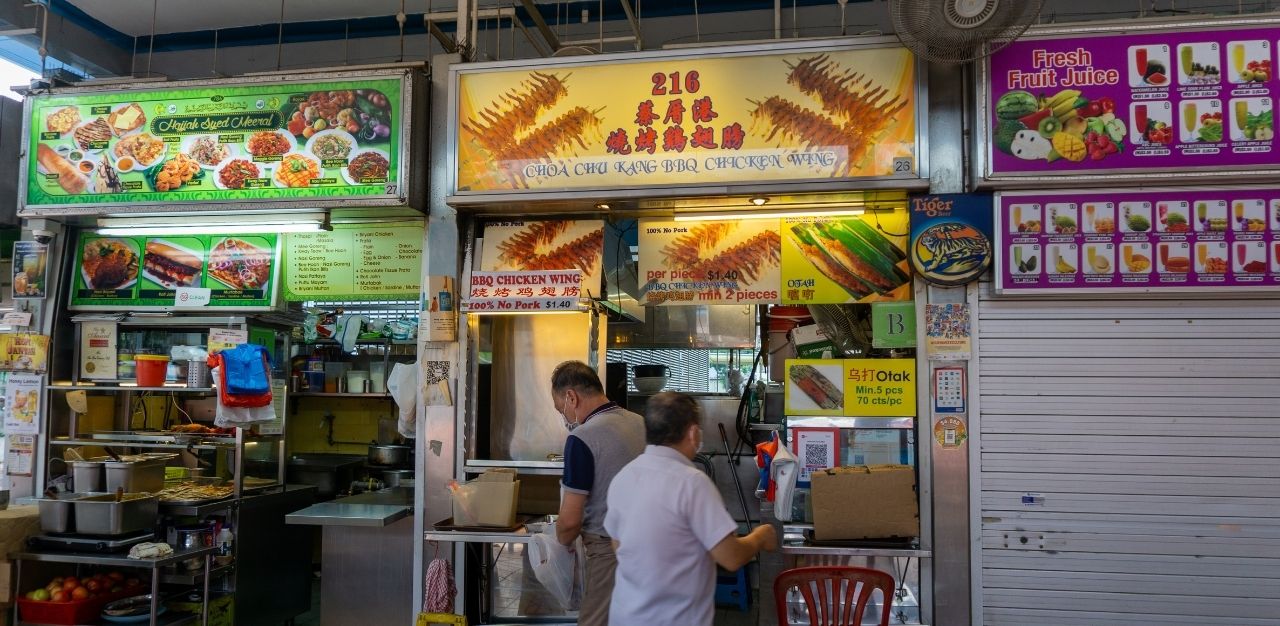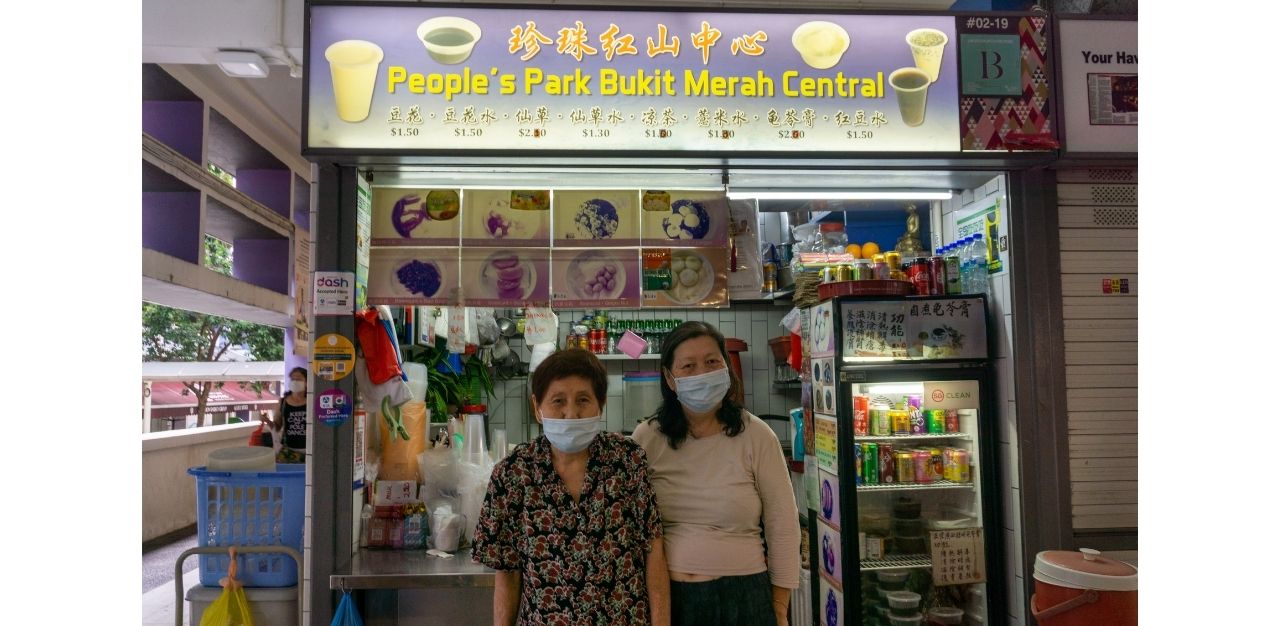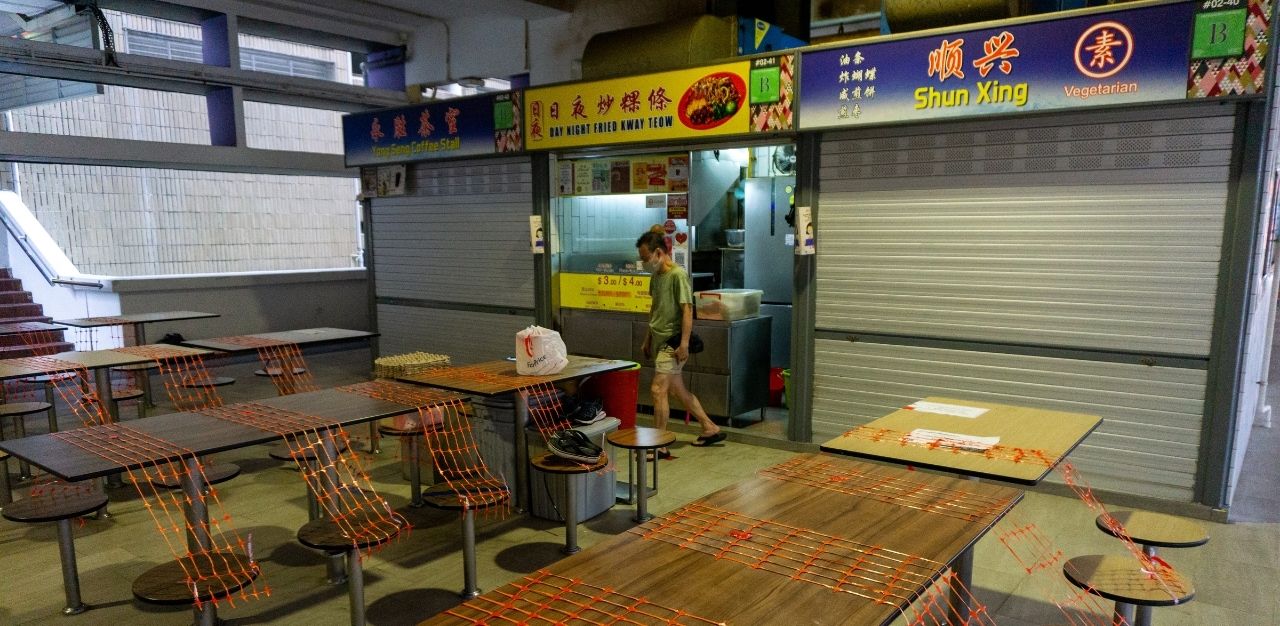Under new phase 2 (heightened alert) restrictions in Singapore, dining-in at food and beverage outlets is prohibited until 13 June. One group of business owners has been hit especially hard by the return of takeaway- and delivery-only rules – Singapore’s elderly hawkers. With some not having the expertise or resources to shift their businesses online, TheHomeGround Asia speaks with them to understand their struggles, and how community efforts may become their lifebuoy.
Where patrons once sat to enjoy their meals, construction tape now wraps around empty tables and chairs at Singapore’s myriad hawker centres – a clear warning to all potential patrons: dining-in not allowed. With little or no customers to serve, food stall owners sit around listlessly; some converse with their neighbours, while others scroll through their phones.
This is the sad reality for many hawkers, nationwide.

Mr Bai, who owns Choa Chu Kang BBQ Chicken Wings at Pasir Panjang Food Centre, reports a 60 to 70 per cent decrease in sales since phase 2 (heightened alert) began. He has been selling barbeque chicken wings at the food centre for over 10 years, and shares that while his regular customers do try to stop by and support him, there are only so many chicken wings they can eat before getting sick of it.
In the same hawker centre, Ken, the owner of KS Fruits Rojak, reports a decline in business by about half.

Another hawker centre in the heartlands, the Bukit Merah Central Food Centre, paints a similar story. While the food centre mostly caters to a lunchtime crowd, with fewer customers later in the day or during weekends and/or public holidays, it was a ghost town when TheHomeGround Asia visited on Vesak Day (26 May).
Owner of Day Night Fried Kuay Teow says that footfall has dropped by nearly half since the new restrictions were put in place.
“We are just hanging in there,” he rues.
Likewise, the mother and daughter team running beverage and beancurd stall People’s Park Bukit Merah Central is finding it difficult to sustain their business, which has been operating for 25 years.

Daughter Mdm Toh says that while they do observe fewer customers during the weekends and public holidays, their business is usually bolstered by church-goers who attend services nearby. With restrictions in place, however, they have lost this customer base that has kept them going most weekends.
She also points out that because people are opting to stay home more during the pandemic, foot traffic has reduced, resulting in a noticeable decrease in sales for many businesses in the neighbourhood.
“I have not been drawing a salary,” says Mdm Toh. “I get an allowance from my brothers now to ensure I have food to eat. It’s been very tough. If the pandemic continues, it will be very draining.”
She adds, “If the Government doesn’t come in to help us, we won’t be able to sustain the business.”
Digitalisation not an option for some
Adapting to a pandemic climate has seen many businesses and eateries shifting their businesses online, where possible. In April 2020, in the face of Singapore’s impending circuit breaker, second-generation hawker Melvin Chew led the charge in this digitalisation process, starting up a Facebook group called Hawkers United – Dabao 2020, a platform that enables hawkers to advertise their stalls online.
The SG Digital Office, too, has implemented measures to help hawkers digitalise under the Hawkers Go Digital initiative, which aims to help more than 18,000 stall holders in hawker centres and wet markets adopt e-payment solutions by mid-2021. Under this scheme, financial initiatives are provided to encourage them to sign up.
Delivery partners such as Grabfood have also devised solutions such as Hawker Centre 2.0, which allows consumers to order from multiple merchants within the same hawker centre in one delivery.
Despite both ground-up and top-down efforts, digitalisation remains a struggle for elderly hawkers, who may be unfamiliar with technology. All four hawkers TheHomeGround Asia interviewed report that their business have remained offline during the pandemic, citing various reasons for the decision.

Mr Bai says that while he did consider engaging partners to deliver his chicken wings, he opted not to as he did not want to “give [these companies] business”, citing high commission rates as a deterrent factor.
For other hawkers like Mr Koh and Mdm Toh, operational limitations and a lack of expertise prevent them from shifting operations online.
Mr Koh explains, “It’s difficult to juggle between walk-ins and delivery orders, especially since we cook on demand.”
Meanwhile, Mdm Toh says that as older women, herself and her mother are less familiar with computers and technology, and are unsure of how to move their business online.
Rallying the community to support elderly hawkers

Upon hearing about the disproportionate struggles of elderly hawkers, especially those who are illiterate, 24-year-old Jocelyn Ng resolved to help where she could. Alongside her two older sisters, Jasmine and and Jacquelyn, they set up @wheretodapao on Instagram to share the stories of elderly hawkers in a bid to get the community to support those in their neighbourhood.
Their initiative has drawn over 28,000 followers in the span of a week.
In speaking with these hawkers to understand their stories, Ms Ng herself was heartened by their tenacity and kind hearts. She talks about a hawker who sold her car so she could continue running her business. Others remain resolute: They prepare the same amount of food each day, hoping that business would eventually pick up.
“At 4pm or so, not much [of their food] has been sold and there’s a lot left. They will feel very disappointed,” says Ms Ng. “They will then give the leftovers to taxi drivers and all these people [free of charge]. It’s quite sad, but you also know how kind-hearted they are.”
Ms Ng says that by sharing these stories, people might be “touched” and “more inclined to help them”.
Meanwhile, influential personalities, like Makansutra Founder KF Seetoh, have also spoken up about the plight of hawkers. In particular, Mr Seetoh has called for more people to patronise hawkers in the heart of town, as these locations have seen the largest drop in footfall due to offices shifting to a work-from-home arrangement.
In support of these hawkers, Mr Seetoh is now doing regular walkabouts in selected hawker centres to put a spotlight on this easily overlooked community.
How you can help
Submit your stories about elderly hawkers to @wheretodapao through this link, and the Ng sisters will continue to feature three stalls every day.
Or order your next meal from these struggling hawkers; it does not hurt either to chat with them and offer a listening ear when you can.
Join the conversations on TheHomeGround Asia’s Facebook and Instagram, and get the latest updates via Telegram.














